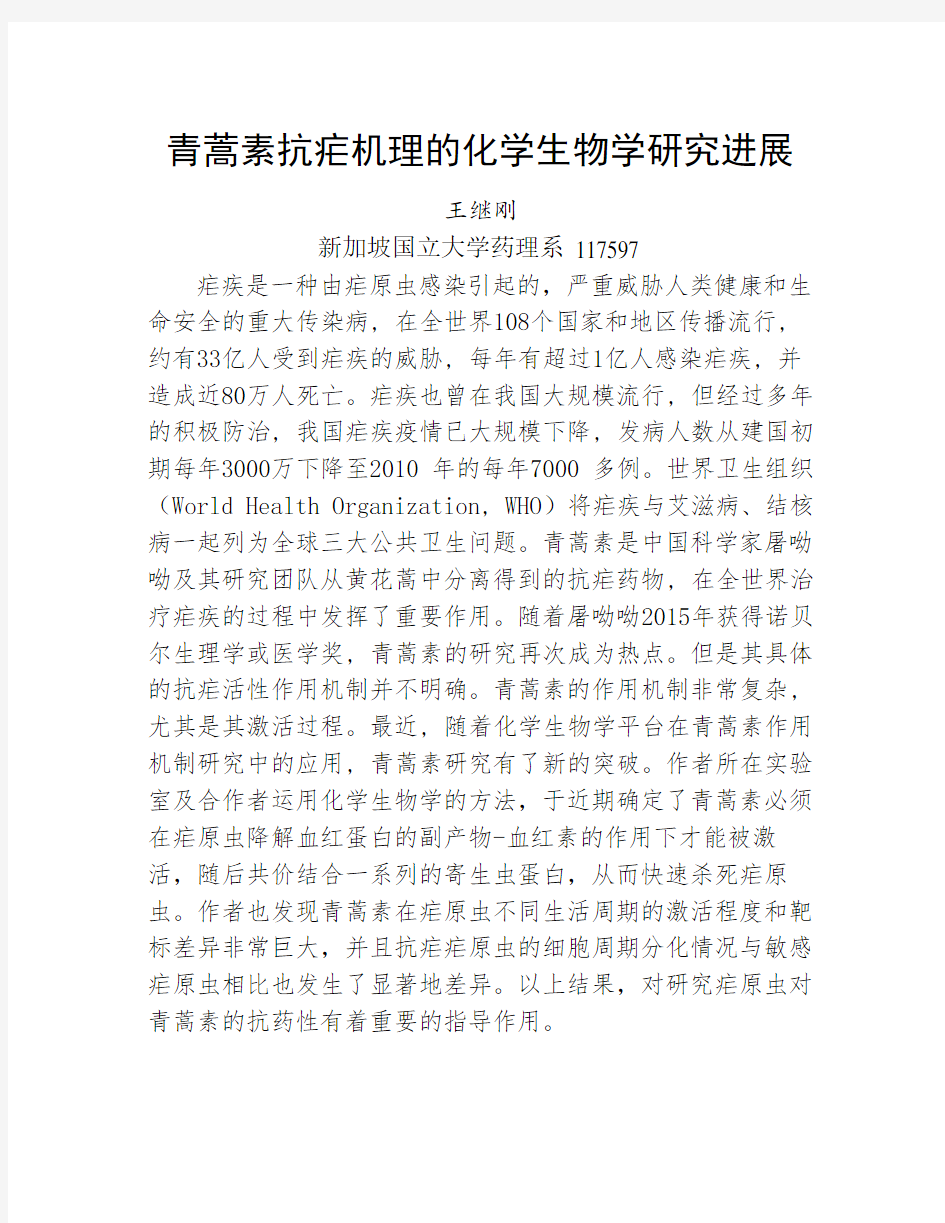讲座摘要及代表性论文.

- 1、下载文档前请自行甄别文档内容的完整性,平台不提供额外的编辑、内容补充、找答案等附加服务。
- 2、"仅部分预览"的文档,不可在线预览部分如存在完整性等问题,可反馈申请退款(可完整预览的文档不适用该条件!)。
- 3、如文档侵犯您的权益,请联系客服反馈,我们会尽快为您处理(人工客服工作时间:9:00-18:30)。
青蒿素抗疟机理的化学生物学研究进展
王继刚
新加坡国立大学药理系 117597
疟疾是一种由疟原虫感染引起的,严重威胁人类健康和生命安全的重大传染病, 在全世界108个国家和地区传播流行, 约有33亿人受到疟疾的威胁, 每年有超过1亿人感染疟疾, 并造成近80万人死亡。疟疾也曾在我国大规模流行, 但经过多年的积极防治, 我国疟疾疫情已大规模下降, 发病人数从建国初期每年3000万下降至2010 年的每年7000 多例。世界卫生组织(World Health Organization, WHO)将疟疾与艾滋病、结核病一起列为全球三大公共卫生问题。青蒿素是中国科学家屠呦呦及其研究团队从黄花蒿中分离得到的抗疟药物, 在全世界治疗疟疾的过程中发挥了重要作用。随着屠呦呦2015年获得诺贝尔生理学或医学奖, 青蒿素的研究再次成为热点。但是其具体的抗疟活性作用机制并不明确。青蒿素的作用机制非常复杂, 尤其是其激活过程。最近, 随着化学生物学平台在青蒿素作用机制研究中的应用, 青蒿素研究有了新的突破。作者所在实验室及合作者运用化学生物学的方法,于近期确定了青蒿素必须在疟原虫降解血红蛋白的副产物-血红素的作用下才能被激活,随后共价结合一系列的寄生虫蛋白,从而快速杀死疟原虫。作者也发现青蒿素在疟原虫不同生活周期的激活程度和靶标差异非常巨大,并且抗疟疟原虫的细胞周期分化情况与敏感疟原虫相比也发生了显著地差异。以上结果,对研究疟原虫对青蒿素的抗药性有着重要的指导作用。
The recent progress of chemical biology in artemisinin mechanism
research
WANG Jigang
Department of Pharmacology, National University of Singapore, Singapore 117597,
Singapore
王继刚, E-mail: wangjigang@
Artemisinin is the active principle extract of sweet wormwood, Artemisia annua which is used to relieve pain and fever in the older days. Today, artemisinin is widely used as an anti-malarial drug as our first line of defense to combat the emergence of drug resistance malaria parasite. Besides its
anti-malarial properties, artemisinin is being investigated in other diseases. It is found to possess a wide spectrum of pharmacological activities, including anticancer, anti-asthma etc. However, its mechanism of action (MOA) is still not fully understood. Recently, chemical proteomics approach has been used in identify the targets and unravel the mechanism of action of artemisinin. In this talk, I will briefly summarize the recent advances of chemical biology in artemisinin target and mechanism study.
近5年内代表性论文:
( ⃰共同通讯作者,#共同第一作者)
1. Wong YK#, Zhang JB#, Hua ZC, Lin QS, Shen HM*, Wang JG*.(2017) Recent Advances in Quantitative
and Chemical Protoemics for Autophagy Studies. Autophagy. 13, 1472-1486.
2. Wong YK, Xu CC, Kalesh KA, He YK, Lin QS, Wong WS*, Shen HM*, Wang JG*. (2017) Artemisinin as
an Anti-Cancer Drug: Recent Advances in Target Profiling and Mechanisms of Action. Medicinal Research Reviews, 37, 1492-1517.
3. Wang JG#*, Zhang CJ#, Chia WN, Loh CCY, Li ZJ, Lee YM, He YK, Yuan LX, Lim TK, Liu M, Liew CX,
Lee YQ, Zhang JB, Lu NC, Lim CT, Hua ZC, Shen HM, Tan KSW*, Lin QS*. (2015) Haem-activated Promiscuous Targeting of Artemisinin in Plasmodium falciparum. Nature Communications, 6:10111.
(Faculty of 1000 recommended as being of exceptional significance; Highlighted in ACS Chemical and Engineering News; Highlighted in NatureAsia; Highlighted in ACS Chemical Biology; Highly cited paper in the field of Biology & Biochemistry in 2016)
4. Wang JG#, Zhang JB#, Lee YM, Ng S, Shi Y, Hua Z-C, Lin QS, Shen HM. (2017). Nonradioactive
quantification of autophagic protein degradation with L-azidohomoalanine labelling. Nature Protocols, 12, 279-288.
5. Wang JG#*, Zhang JB#, Shi Y#, Xu CC#, Zhang CJ, Wong YK, Lee YM, Krishna S, He YK, Lim TK, Liu B,
Hua ZC, Shen HM*, Lin QS*. (2017). Mechanistic Investigation of the Specific Anticancer Property of Artemisinin and Its Combination with Aminolevulinic Acid for Enhanced Anti-colorectal Cancer Activity.
ACS Central Sciences, 3, 743-750. (Cover story of the issue)
6. Zhang CJ#, Wang JG#*, Zhang JB, Lee YM, Feng GX, Lim TK, Shen H-M, Lin QS*, Liu B*. (#equal
contribution). (2016) Mechanism-Guided Design and Synthesis of Mitochondria- targeting Artemisinin Analog with Enhanced Anticancer Activity. Angew. Chem. Int. Ed., 55, 13770-13774.
7. Wang JG#*, Xu CC#, Lun ZR*, Meshnick SR. (2017) Unpacking “Artemisinin Resistance”. Trends in
Pharmacological Sciences, 38, 506-511
8. Wang JG#*, Gao LQ#, Lee YM#, Kalesh KA, Ong YS, Lim J, Lee JE, Sun HY, Lee SS*, Hua ZC*, Lin
QS*. (2016) Target identification of natural and traditional medicines with quantitative chemical proteomics approaches. Pharmacology & Theraputics, 162, 10-22.
9. Zhang JB#, Wang JG#, Zhou ZH, Zhang CJ, Eun PJ, Wu S, Sze SK, Lin QS, Shen HM. (2017)
Acetylation of TFEB activates lysosomal function in response to histone deacetylase inhibitor SAHA treatment. Autophagy, 10.1080/15548627.2018.1447290.
10. Wang JG#, Zhang JB#, Lee YM, Koh PL, Ng SK, Bao FC, Hua ZC, Lin QS*, Shen HM*. (2016).
Quantitative Chemical Proteomics Profiling of de novo Proteins Synthesis during Starvation-Mediated Autophagy,Autophagy, 12, 1931-1944.
11. Zhang JB#, Wang JG#, Ng S, Lin QS*, Shen HM*. (2014). Development of a novel method for
quantification of autophagic protein degradation by AHA labeling. Autophagy, 10, 901-912.
12. Chen X, Li W, Xu CC, Wang J, Zhu B, Huang Q, Chen D, Sheng J, Zou Y, Lee YM, Tan RX, Shen P,
Wong YK, Lin Q, Wang JG*, Hua ZC*. (2018). Comparative profiling of analog targets: a case study on resveratrol for mouse melanoma metastasis suppression. Theranostics, in press.
13. Wang JG#, Tan XF#, NguyenVS, Yang P, Zhou J, Gao MM, Li ZJ, Lim TK, He YK, Ong CS, Lay YF,
Zhang JB, Zhu GL, Lai SL, Ghosh D, Mok YK, Shen HM, Lin QS. (2014). A Quantitative Chemical Proteomics Approach to Profile the Specific Cellular Targets of Andrographolide, a Promising Anticancer Agent that Suppresses Tumor Metastasis. Molecular & Cellular Proteomics, 13, 876-886. 14. Wang JG*#, Wong YK#, Zhang JB#, Lee YM, Hua ZC*, Shen HM*, Lin QS*. (2017). Drug Target
Identification using an iTRAQ-Based Quantitative Chemical Proteomics Approach. Methods Enzymol., 586, 291-309.
15. Zhang JB#, Wang JG#, Lee YM, Lim TK, Lin QS, Shen HM. (2017). Proteomic profiling of de novo
protein synthesis in starvation-induced autophagy using bio-orthogonal noncanonical amino acid tagging. Methods Enzymol., 588, 41-59.
